The sax season has finally started in Newfoundland....just a few open yet...lots in bud. here is Saxifraga oppositifolia and S. sancta
Comments
Re: Saxes in 2011
Lori:
I have found growing lots of Saxifraga oppositifolia very rewarding. They are easy to propagate and the European forms will always flower beautifully. The catch is that they have very particular growing requirements. I have found they have to be planted in a north facing slope shaded by rocks from the sun in the summer. Our flowering has just finished this year. Here is a sample from a couple of weeks ago.
Re: Saxes in 2011
Wow, beautiful, David! Planting them in the shade of rock crevices makes sense... that seems to be where I see them in the mountains. As I extend the tufa garden this year, my thought is to create shady, north-facing slopes... I was thinking of Haberlea and Ramonda there, but perhaps S. oppositifolia would be happy there too?
Re: Saxes in 2011
Lori:
You are right in your thinking. I grow Haberlea and Ramonda in exactly the same garden habitat as Sax oppositifolia. They all do well in our north facing crevices. This year was not the best for flowering of Saxifraga oppositifolia so I have attached a few photos from previous years.
Re: Saxes in 2011
Beauties David! Wish the NL form was as reliable for blooms.
Re: Saxes in 2011
Saxifraga oppositifolia is one of the earliest flowers where I live growing on the rocky headland (Malvik Odden, Central Norway) seen from my house in the first picture and regularly exposed in winter to seaspray. I had a walk out there today and show a few pictures. I was told recently that a white form grew there - had a good search, but didn't find it. Loons (Red Throated Divers) were displaying out in the bay as I took my pictures - waiting fo the ice to disappear from their breeding lakes inland... I've tried to introduce it in my garden unsuccessfully (on the north side of my house).
Re: Saxes in 2011
Very nice, David!
Stephen, I didnt know rødsildre grew there!
Re: Saxes in 2011
Malvik Odden has a lot of nice plants, many of which are otherwise only found in the mountains, including this one:
Re: Saxes in 2011
That's incredible Steven that you can see Sax oppositifolia by walking from your house. The North Cascades are our closest mountains and Sax oppositifolia only grows above 2000m. It is very hard to see the plant in flower in our mountains as it flowers in June when the access routes are still snow covered.
The North American populations of Sax oppositifolia are quite different from the European forms. The flowers are not so spectacular here but the foliage is very tight, unlike the lax growth in Europe. Here is a picture of a huge bun (about 0.7m wide) of Sax oppositifolia growing at 2000m in the North Cascades.
Re: Saxes in 2011
Very different indeed, David. I have never seen oppositifolia make any kind of cushions here!
Re: Saxes in 2011
Yes, I can actually walk downhill to see Purple Saxifrage :) I've always wondered if the mountain and shoreline populations are genetically distinct. Could you move a plant from the mountains to the shore and would it cope with the salt stress?
I don't think I would have recognised your cushion for what it is!
Re: Saxes in 2011
Stephen:
That cushion is as hard as a rock. All the Saxifraga oppositifolia are like that in the Coast Ranges. Here is a close-up of the foliage.
Re: Saxes in 2011
Great picture. Old Growth Purple Saxifrage? How long to grow one of these in a garden?
Being interested in ethnobotany, I was intrigued to see it referred to as an "Edible Plant" in the wiki entry: http://en.wikipedia.org/wiki/Saxifraga_oppositifolia, but there is no reference. I know other saxifrages were used traditionally for food by native american peoples in the arctic, but hadn't come across this species before and it's not mentioned in David Moerman's comprehensive Native American Ethnobotany. Reading on, it seems to be the flowers which were used...pretty spring salad...
Sorry, I digress...
Re: Saxes in 2011
Stephen:
That cushion is as hard as a rock. All the Saxifraga oppositifolia are like that in the Coast Ranges. Here is a close-up of the foliage.
Looks more like the cushions I observed in Andes or mesembs from South Africa!
Re: Saxes in 2011
If anyone is interested in visiting this big bun the access and route can be found here.
http://www.mountainflora.ca/Flora_of_the_Coast_Ranges/Skyline_Divide-Cho...
For armchair visitors there is a video of the hike on the above page that includes the location of the Saxifraga oppositifolia.
Re: Saxes in 2011
David thanks so much for the link! :) I just watched the video..oh my...what beauty!! Adding another place I must visit to my list.

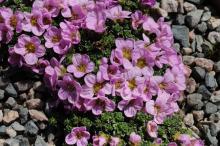
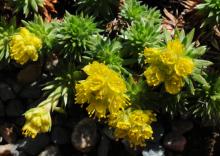
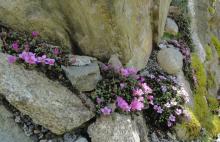
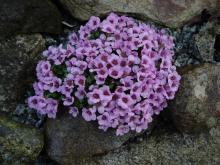
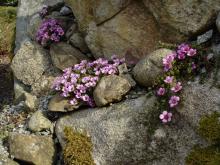
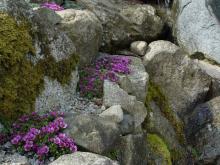
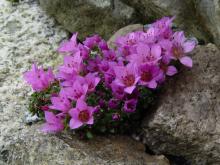
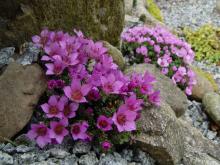
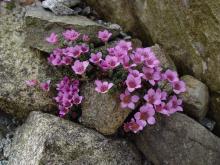
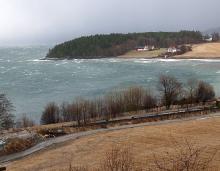

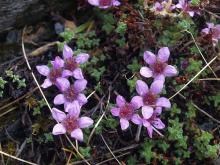
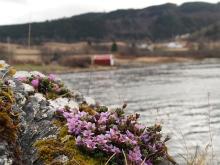
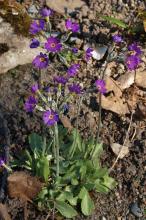
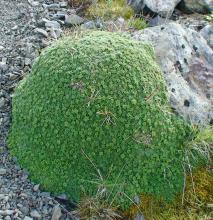
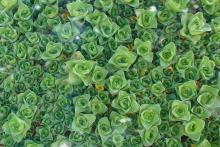
Very nice, Todd!
It has suddenly occurred to me that growing lots of S. oppositifolia is a brilliant idea... I usually miss them in the wild (not wishing to slog through miles of snow) but if I grew them in the yard, I could just dig them out of the snow to enjoy the bloom! :rolleyes:
You're way ahead of us (grumble, grumble)... still just buds on S. sancta var. macedonica:
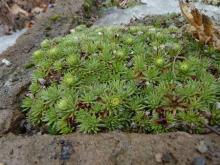
Okay, y'know all the whining I did about the late spring last year? I take it all back... THIS is the worst year ever! I haven't even been able to cut all the perennials off yet! >:(